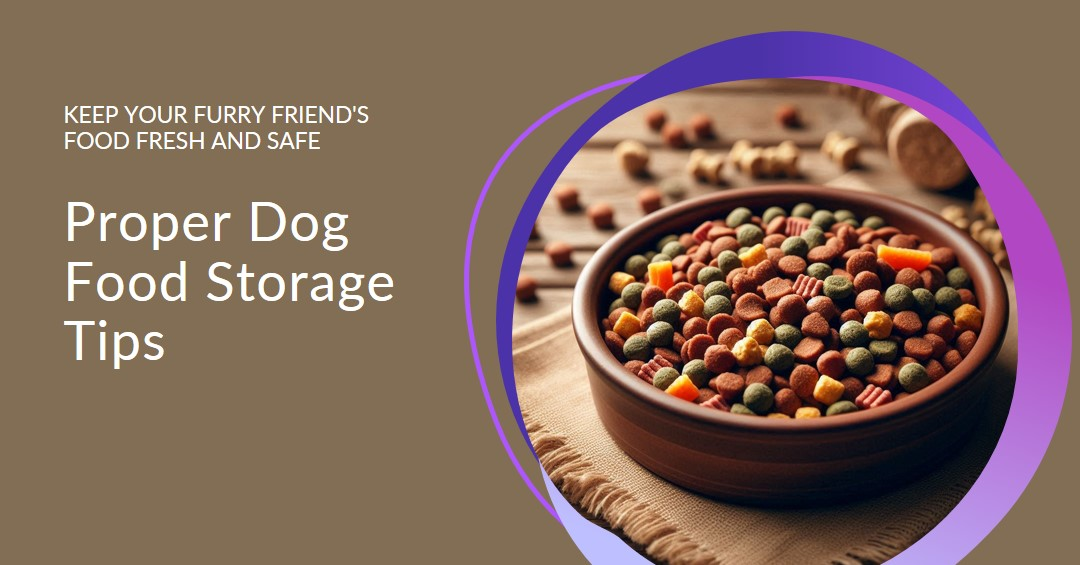
Storing dog food correctly is crucial for maintaining its freshness, nutritional value, and safety. Let’s explore the best practices for storing different types of dog food, including dry kibble, wet food, and homemade dog food.
Storing Dry Dog Food
Dry dog food, or kibble, is the most common type of dog food. To keep it fresh and free from pests, follow these guidelines:
- Original Packaging: Keep the kibble in its original packaging. The packaging is designed to preserve the food’s freshness and protect it from light and air.
- Airtight Containers: Place the original bag inside an airtight container. This adds an extra layer of protection against moisture and pests. Make sure the container is clean and dry before use.
- Cool, Dry Place: Store the container in a cool, dry place, away from direct sunlight. Excess heat and humidity can cause the food to spoil faster.
- Use Within Timeframe: Check the expiration date and try to use the food within a month of opening the bag. This ensures that your dog is eating fresh food.
How to Store Leftover Dog Food
Leftover dog food, especially wet food, needs special care to keep it from spoiling:
- Refrigerate Immediately: If your dog doesn’t finish their meal, refrigerate the leftovers as soon as possible. Wet food can spoil quickly if left out.
- Airtight Containers: Store the leftover food in an airtight container to prevent it from drying out and absorbing odors from other foods in the fridge.
- Label and Date: Label the container with the date you opened the can or pouch. This helps you keep track of how long the food has been stored. Generally, wet food should be used within 3-5 days.
- Check for Spoilage: Before serving leftovers, check for signs of spoilage, such as a bad smell, mold, or discoloration. If the food looks or smells off, discard it.
What is the Best Way to Store Homemade Dog Food?
Homemade dog food requires careful storage to ensure it remains safe and nutritious:
- Cool Quickly: After cooking, cool the food quickly to prevent bacterial growth. Divide the food into smaller portions to help it cool faster.
- Portion Control: Store the food in portion-sized containers. This makes it easy to thaw and serve the right amount at each meal.
- Freezer Storage: For long-term storage, freeze homemade dog food. Use freezer-safe, airtight containers or freezer bags to prevent freezer burn. Label each container with the date and type of food.
- Refrigeration: If you plan to use the food within a few days, store it in the refrigerator. Homemade dog food can be kept in the fridge for up to 3-4 days.
- Thawing: When you’re ready to use frozen dog food, thaw it in the refrigerator overnight. Avoid thawing at room temperature to prevent bacterial growth.
Tips for All Types of Dog Food
Regardless of the type of dog food you’re storing, these tips will help keep it safe and fresh:
- Cleanliness: Always wash your hands before handling dog food. Clean bowls, scoops, and storage containers regularly to prevent contamination.
- Avoid Bulk Buying: While it may be tempting to buy dog food in bulk, it’s best to buy smaller quantities that your dog can consume within a month or so. This ensures that the food remains fresh.
- Temperature Control: Avoid storing dog food in areas with extreme temperatures, such as garages or sheds. Consistent, moderate temperatures are ideal for maintaining food quality.
Dog food Packaging
One innovative solution for storing dog food, especially homemade and leftover food, is using printed child-resistant mylar bags. These bags offer several benefits:
- Child Safety: Child-resistant bags ensure that curious children cannot easily access the food, adding a layer of safety.
- Freshness: Mylar bags are excellent at keeping out moisture, light, and air, which helps preserve the food’s freshness and nutritional value.
- Customizable: Printed mylar bags can be customized with labels and designs, making it easy to keep track of different types of food and their preparation dates.
- Portability: These bags are lightweight and portable, making them convenient for storing portions of food, especially when traveling.
- Durability: Mylar is a durable material that resists tearing and puncturing, providing long-lasting protection for the food inside.
Conclusion
Proper storage of dog food, whether it’s dry kibble, wet food, or homemade meals, is essential for your dog’s health and well-being. By following these guidelines, you can ensure that your dog’s food stays fresh, safe, and nutritious. Remember to use airtight containers, store food in cool, dry places, and always check for signs of spoilage before serving. Additionally, consider using printed child-resistant mylar bags for an extra layer of protection and convenience.